Silk and sunshine. They’re a fabulous combination.
A while back, I showed you the beginnings of this embroidery project. I thought I’d share a little progress on the piece today – especially since we’ve had some sunny days lately that were ideal for playing around with different lighting.
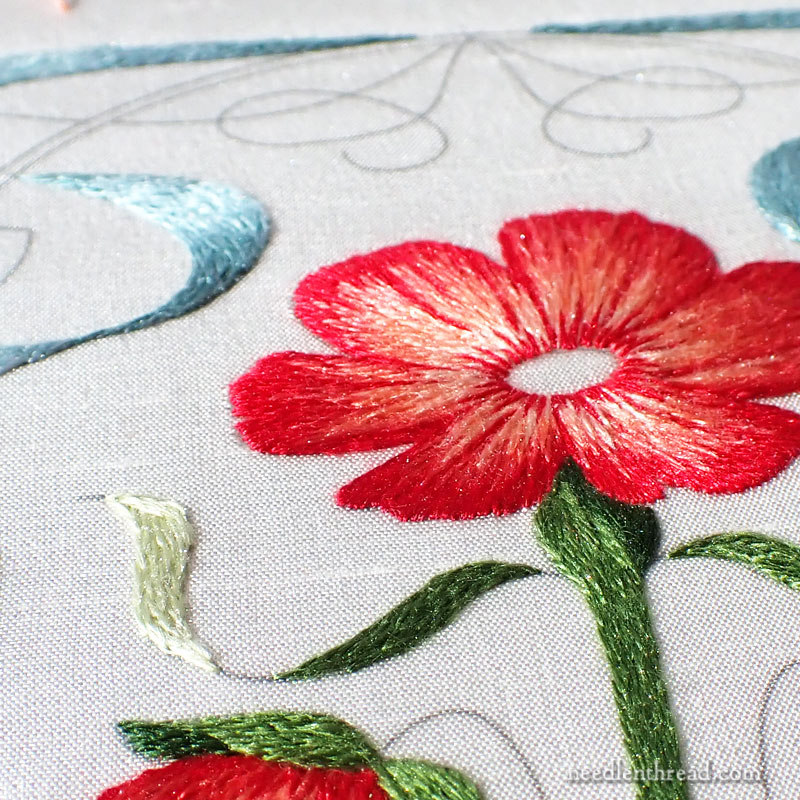
This Art Nouveau-ish project that we’re working on right now has a somewhat limited color palette, but within the color families that we’re using, we have some shading going on.
We’re using Au Ver a Soie’s Soie d’Alger (which is a spun stranded silk) for all the thread, along with some goldwork threads.
If you’re not familiar with silk threads and their differences, I’ve got a series of articles that will introduce you to the ins and outs of silk embroidery thread. You can read those articles through the links below:
- Silk Hand Embroidery Thread 101: Getting Started with Silk
- Silk Hand Embroidery Thread: Twisted Filament Silk
- Silk Hand Embroidery Thread: Flat Silk

One aspect of silk that always amazes me is the way that light affects it.
Sure, light affects every kind of embroidery thread! But the way light plays on silk is really fascinating. It’s just so much more playful than it is on most other threads.
Take, for example, the seemingly dark gray-blue strip of embroidery in the image above.
Let’s talk the frame in the sunlight just ever-so-slightly:
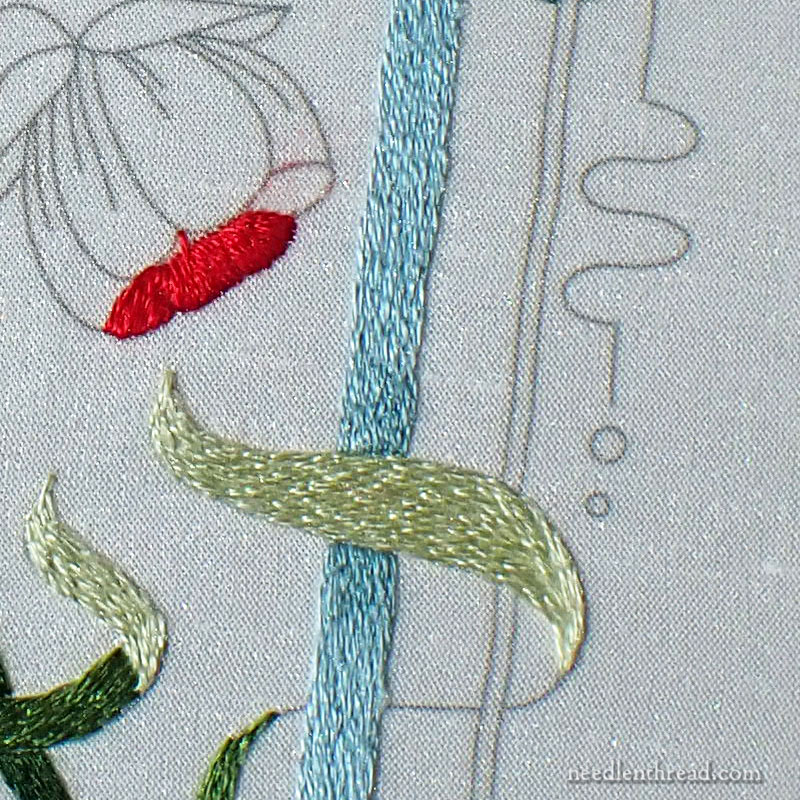
Not quite so dark looking now, is it?
As the lighting shifts, out comes more blue and the whole color softens.
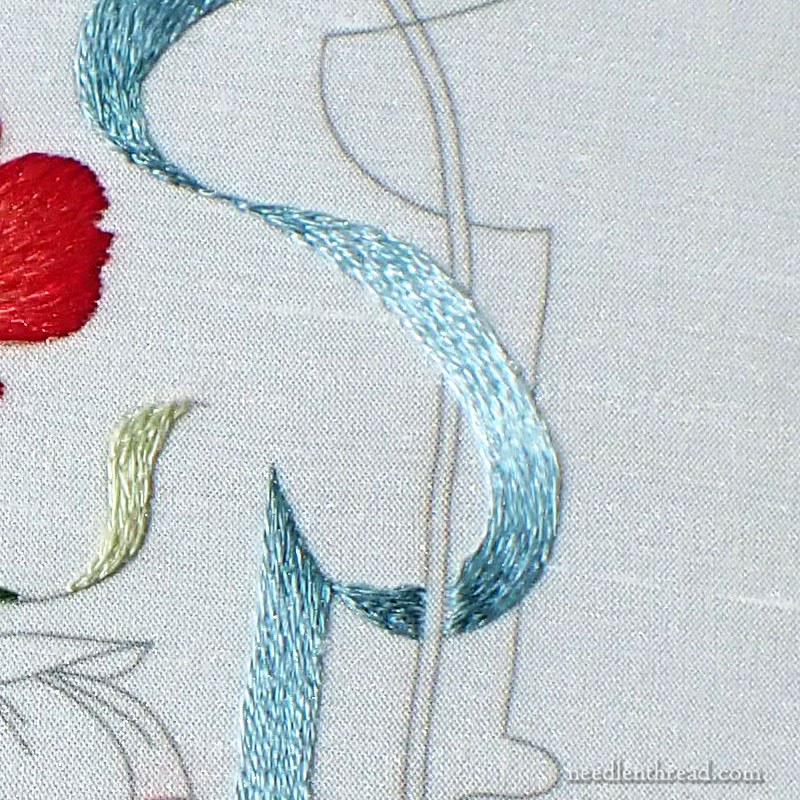
Here, you can see the influence of shading techniques on the ribbon-like frame – it almost looks dimensional as it balloons out and passes over the thin bar behind it.
The light helps to bring out the brightness in that area of shading.
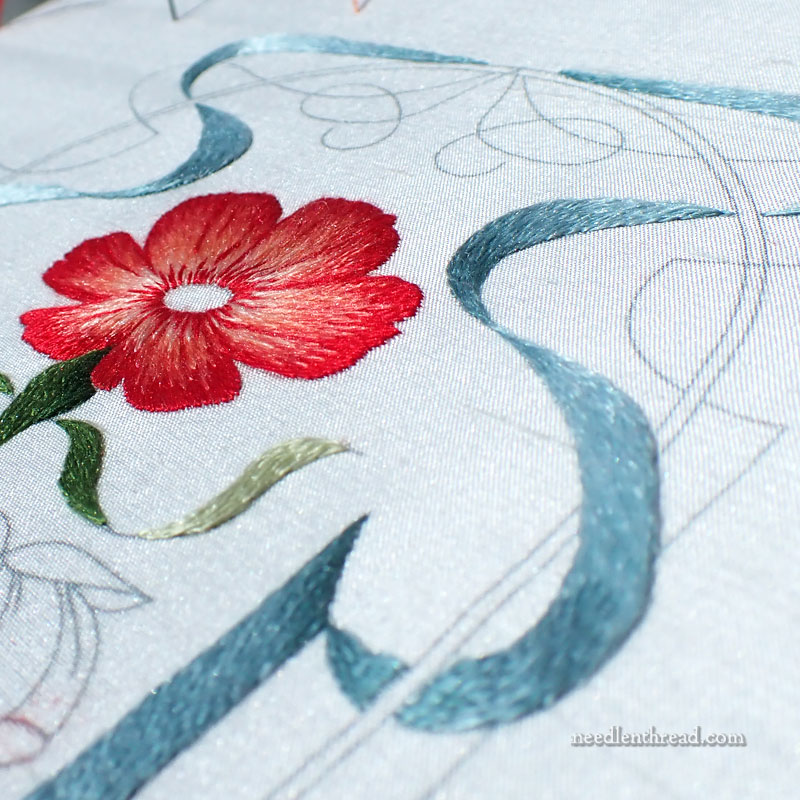
With the frame shifted slightly, the ribbon becomes a bit darker, and the darker shadows stand out even more.
Stitching with Silk
If you read through the articles I linked to above, you’ll discover that there are several different types of silk threads that you can embroider with.
Silk is often intimidating to stitchers if they’ve never used it before. Mostly, I think this is because of two things: 1. the price (good silk is more expensive than standard cotton floss); and 2. preconceived notions that, when you’re stitching with more expensive materials, the needlework somehow must be more challenging or difficult.
While #1 is a fact that can’t be disputed and will likely never change (and has always been the case throughout the history of needlework in the western world), #2 is simply not true.
You can embroider with silk as easily as you can with cotton floss, especially if you’re using stranded spun silk, which, in structure and use, is much like stranded cotton. The difference between the two is the higher natural sheen that comes with real silk threads – a sheen that does not diminish over time.
The sheen on cotton thread comes through a chemical process called mercerization. The sheen on silk thread is natural – it is part of the nature of silk. Mercerization can only go so far to produce a sheen on cotton. And it can’t really compare to the sheen on a high quality silk thread.
And while some might question whether or not it’s worth the price to stitch with silk, I can guarantee you that the difference between silk and cotton is remarkable on a finished piece of embroidery.
Silk threads elevate a project.
And that’s why, with this particular design – which is graceful and a little formal – we wanted to use silk. The end results will be worth it!



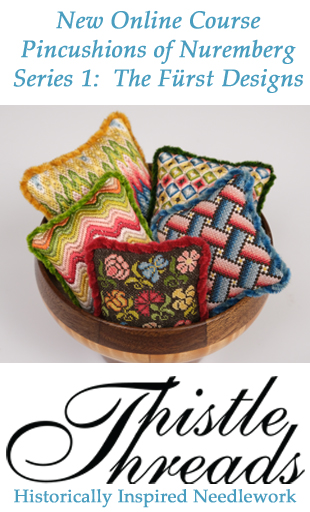
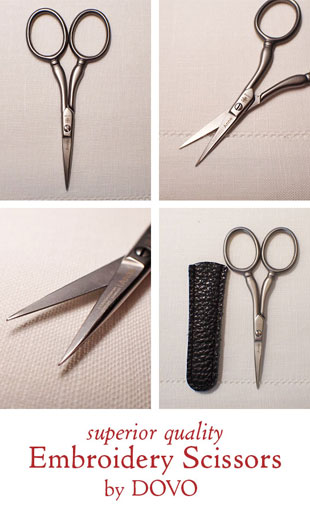
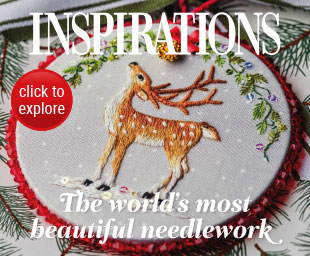

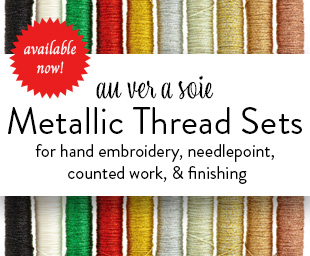
Ooh, this project is coming along beautifully! And I also love stitching with Soie d’Alger; it’s pricy, but so gorgeous. Just perfect for silk shading/long and short stitch.
Oh this is beautiful, especially the first photo. Looking forward to seeing more.
I love to embroider with silk. I prefer Valdani, because I don’t dry clean my clothes. My blouses can be simply washed and line dried. Because Valdani is wash fast, I never have to worry about bleeding colors.
I don’t recommend silk for embroidering clothes that require washing every week, for that, stick with cotton. I did an apron, not my best idea. All the silk is very dull. 200 washes will do that.
Using Au Ver a Soie’s Soie d’Alger, I made a blouse and the black ran, it looked like my embroidery was weeping. I ended up over dyeing it in indigo. The indigo hid the horrible runs, yes the embroidery was very difficult to see. But, I wore it till it fell apart.
Many of my blouses have taken 50 hours of sewing, fitting, and stitching, so imagine spending all that money on linen fabric and silk thread.
It’s a beautiful thread if you are making something that you can dry clean.
Yes, AVAS silks are not something I would embroider with on anything that I’d launder like clothes. But this type of project is not meant for laundering at all. It’ll be framed. If it ever has to be cleaned and I decided to do it with water, cool water is the extent of it, with air drying and no heat. Most silk threads that adhere to the current European standards of dyeing (which comply with certain eco and health regulations) will recommend cool water at most, if laundering – and no heat. (So, no steam ironing and the like, either.) But usually, they recommend dry cleaning. Some brands, though, have their threads dyed in Central Europe, where they don’t have to adhere to the same manufacturing standards that are more carefully regulated in France, and which allows them to use different chemicals and so forth in the dyeing process in order to produce “colorfast” silk threads. So it really depends on where the threads are produced and what the standards of manufacturing are. I would say choose the threads based on the end use of the project. If I were embroidering something that’s going to be regularly laundered, silk threads (from any manufacturer) would not be a first choice for me, only because I wouldn’t put the expense into the threads for something that will wear down more quickly due to regular laundering.
Mary, Are you using the Long and Short stitch here? Thank you. Louisa
Yep!
Hi, Mary! I am enjoying watching the progress of this new project as it develops.
My suggestion for a project name: “Fleur Nouveau Riche.”
Have a great Monday!
Name for your beautiful Art Nouveau piece-“Outside the Castle Window”
So beautiful!! I’ve never used silk embroidery thread before. Would love to try it soon.
Maybe call it Spring Burst?
Looks wonderful
I love the design